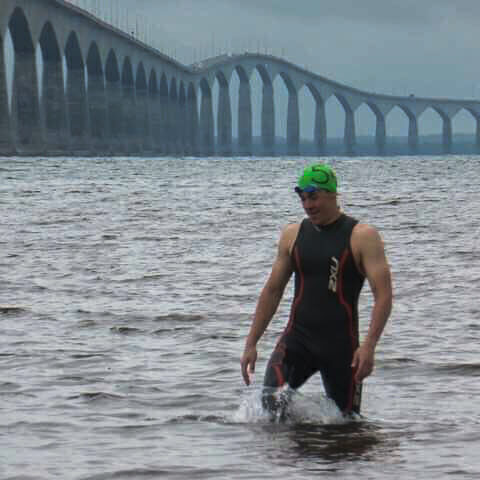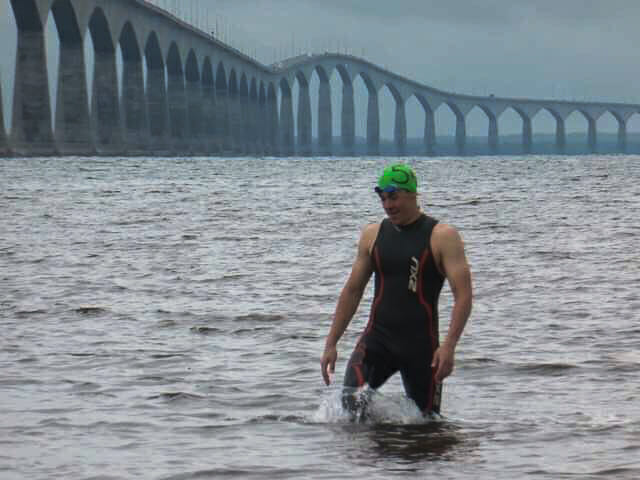
Big Swim causes bigger waves
Tigers alumni swam from New Brunswick to PEI to raise money for a local charity
Standing on the shore of New Brunswick and looking across the Northumberland Strait, all Tyler Immel-Herron could see was the Confederation Bridge disappearing in the distance.
“Not really being able to see the other land, the other side, it’s kind of nerve-wracking,” the Dalhousie University marine affairs student says.
Three hours and 39 minutes later, he stepped foot on PEI soil, having swam across the Strait.
Immel-Herron, along with 43 other swimmers, was taking part in the Big Swim this August, an annual event that raises money for Brigadoon Village.

Feat of endurance
Paige Crowell, a Dalhousie University alumna who swam for the Tigers from 2011-2015, also participated. She was the first woman to finish the swim this year, with a time of three hours and 50 minutes. Originally from PEI, this was her first year doing the Big Swim.
“I knew that it was an event that went on and it just seemed like a fun challenge,” she says. “I really like endurance and distance events so it just seemed like a natural progression.”
The distance of the swim this year was about 15 kilometres and took the average swimmer about six hours. Other years, because of currents that can sweep swimmers off track, that distance can creep up to close to 20 kilometres.
Preparing to be in the water that long was a challenging commitment. Immel-Herron, for instance, often couldn’t find time between juggling two jobs to be in the pool for more than an hour at a time — not a long time, considering the length of the actual swim.
Swimming in the open water
While Immel-Herron, who swam for the Tigers for the past four years, was the first swimmer across and ended up having no problem with the fitness aspect of the swim, the conditions were another story.
The swim is planned so that the tide and current are at the back of the swimmers to help their progress. In addition, each swimmer has a kayaker to ensure their safety. Even so, the conditions of the open ocean can be unpredictable.
In the second half of the swim, the water was fairly wavy and choppy, making it difficult for Immel-Herron to settle into a rhythm with his stroke.
“When you’re swimming for that long, mentally you kind of just want to zone out because you don’t want to think about things and you want time to pass quicker and it did not allow me to do that at all,” he says. “It definitely made it mentally harder to get through.”
This was Immel-Herron’s second time doing the Big Swim. The first was in 2014, when his step-mother was registered but couldn’t swim on the day of, so he took her place.
This year, when she decided to try again, Immel-Herron joined too.
“I just decided that if she was going to do it that I would do it too, kind of as moral support for her,” he says.
Along with Immel-Herron and Crowell, two other Dal swimming alumni, David Sharpe and Jeremy Ryant, participated in the Big Swim this year.
Having the contingent from Dal was a unique experience, says Immel-Herron.
“It was kind of comforting to have people that you knew well around, especially people who were just as good of swimmers as you,” he says, while noting that once in the water, he couldn’t actually see any other swimmers.
There was almost a sense of nostalgia for Crowell.
“It was just fun to be there with friends and people that you’d swam with before,” she says. “[It] kind of felt like we were all back at a swim meet.”
Giving back
The Big Swim raises money for Brigadoon Village, a Halifax-based charity that sends kids with a chronic illness, condition or special needs to week-long camps, where they can meet other youth like themselves and form lasting relationships.
“You forget that not every kid can go to your traditional camp and so it’s just important for [everyone] to have that experience,” says Crowell.
This year, the Big Swim raised more than $160,000 for the non-profit.
“You really felt like you were doing something good to try and raise money for,” says Immel-Herron.






